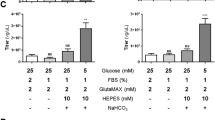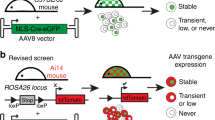Abstract
Recombinant adeno-associated viruses (rAAV) are promising candidates as gene vectors, as they transduce non-dividing cells and permit lasting transgene expression in a wide spectrum of tissues. In this paper, we describe a robust procedure for the high throughput production, screening and characterization of rAAV vectors. The technology includes the production of rAAV from rapid small scale plasmid preparations and the analysis of virus productivity (physical and infectious particles) and activity (transgene expression, replication). rAAV are produced by triple transfection (rAAV plasmid and AAV- and adenovirus (Ad)-helper plasmids) on 293 human embryo kidney (HEK) cells. The titers of physical and infectious particles are obtained by dot blot hybridization and by a serial dilution assay, followed by either dot blot hybridization or real-time PCR, respectively. rAAV can be produced and characterized from plasmid mixtures containing as little as 1/100 productive molecules. Experiments on rAAV replication kinetics and Ad helper functions are discussed. All steps are performed in 96-well microtiter plates. The process is reproducible, high throughput, linear and ready for automation.
This is a preview of subscription content, access via your institution
Access options
Subscribe to this journal
Receive 12 print issues and online access
$259.00 per year
only $21.58 per issue
Buy this article
- Purchase on Springer Link
- Instant access to full article PDF
Prices may be subject to local taxes which are calculated during checkout








Similar content being viewed by others
References
Mulligan RC . The basic science of gene therapy Science 1993 260: 926–932
Verma IM, Somia N . Gene therapy – promise, problems and prospects Nature 1997 389: 239–242
Atkinson EM, Debelak DJ, Hart LA, Reynolds TC . A high-throughput hybridisation method for titer determination of viruses and gene therapy vectors Nucleic Acids Res 1998 26: 2821–2823
Vidal M, Endoh H . Prospects for drug screening using the reverse two-hybrid system Trends Biotechnol 1999 17: 374–380
Sykes KF, Johnston SA . Linear expression elements: a rapid in vivo, methods to screen for gene functions Nat Biotechnol 1999 17: 355–359
Mahairas GG et al. Sequence-tagged connectors: a sequence approach to mapping and scanning the human genome Proc Natl Acad Sci USA 1999 96: 9739–9744
Hanzel DK, Trojanowski JQ, Johnston RF, Loring JF . High-throughput quantitative histological analysis of Alzheimer's disease pathology using a confocal digital microscanner Nat Biotechnol 1999 17: 53–57
Mazumder A, Majlessi M, Becker MM . A high throughput method to investigate oligodeoxyribonucleotide hybridization kinetics and thermodynamics Nucleic Acids Res 1998 26: 1996–2000
Davis AR, Meyers K, Wilson JM . High throughput method for creating and screening recombinant adenoviruses Gene Therapy 1998 5: 1148–1152
Hallek M et al. Recombinant adeno-associated virus vectors Curr Res Mol Ther 1998 1: 417–430
Flotte TR, Carter BJ . Adeno-associated virus vectors for gene therapy Gene Therapy 1995 2: 357–362
Herzog RW et al. Stable gene transfer and expression of human blood coagulation factor IX after intramuscular injection of recombinant adeno-associated virus Proc Natl Acad Sci USA 1997 94: 5804–5809
Snyder RO et al. Efficient and stable adeno-associated virus-mediated transduction in the skeletal muscle of adult immunocompeted mice Hum Gene Ther 1997 8: 1891–1900
Goodman S et al. Recombinant adeno-associated virus-mediated gene transfer into hematopoietic progenitor cells Blood 1994 84: 1492–1500
Bartlett JS, Samulski RJ, McCown TJ . Selective and rapid uptake of adeno-associated virus type 2 in brain Hum Gene Ther 1998 9: 1181–1186
Bennett J et al. Stable transgene expression in rod photoreceptors after recombinant adeno-associated virus-mediated gene transfer to monkey retina Proc Natl Acad Sci USA 1999 96: 9920–9925
Dudus L et al. Persistent transgene product in retina, optic nerve and brain after intraocular injection of rAAV Vision Res 1999 39: 2545–2553
Snyder RO et al. Correction of hemophilia B in canine and murine models using recombinant adeno-associated-virus vectors Nature Med 1999 5: 64–70
Salvetti A et al. Factors influencing recombinant adeno-associated virus production Hum Gene Ther 1998 9: 695–706
Snyder RO, Xiao X, Samulski RJ . Production of recombinant adeno-associated viral vectors. In: Dracopoli N et al (eds) Current Protocols in Human Genetics John Wiley and Sons: New York 1996 12.1.1–12.1.24
Heid CA, Stevens J, Livak KJ et al. Real-time quantitative PCR Genome Res 1996 6: 986–994
Qing K et al. Human fibroblast growth factor receptor 1 is a co-receptor for infection by adeno-associated virus 2 Nature Med 1999 5: 71–77
Li J, Samulski RJ, Xiao X . Role for highly regulated rep gene expression in adeno-associated virus vector production J Virol 1997 71: 5236–5243
Xiao X, Li J, Samulski RJ . Production of high-titer recombinant adeno-associated virus vectors in the absence of helper adenovirus J Virol 1998 72: 2224–2232
Acknowledgements
We thank Karin Jooss, Eric Kremer, Philippe Moullier and Nestor Soria for critically reading of the manuscript; Nasser Armande and Pascal Martinez for the computer program developed for the tangential hyperbole-based analysis; and for kindly providing mini-prep rAAV-lacZ plasmid (Pascale Bouille) Ad2, Ad5, ts-Ad adenoviruses, rep+/cap+ HeLa cells and pAAV-lacZ (Philippe Moullier and Anna Salvetti), CAV-1 and CAV-2 (Eric Kremer) and pAB11, pACG.2 and pXX6 plasmids (R Jude Samulsky).
Author information
Authors and Affiliations
Rights and permissions
About this article
Cite this article
Drittanti, L., Rivet, C., Manceau, P. et al. High throughput production, screening and analysis of adeno-associated viral vectors. Gene Ther 7, 924–929 (2000). https://doi.org/10.1038/sj.gt.3301191
Received:
Accepted:
Published:
Issue Date:
DOI: https://doi.org/10.1038/sj.gt.3301191
Keywords
This article is cited by
-
Homology-directed repair of an MYBPC3 gene mutation in a rat model of hypertrophic cardiomyopathy
Gene Therapy (2023)
-
Efficient gene delivery to the cone-enriched pig retina by dual AAV vectors
Gene Therapy (2014)
-
AAV-mediated photoreceptor transduction of the pig cone-enriched retina
Gene Therapy (2011)



